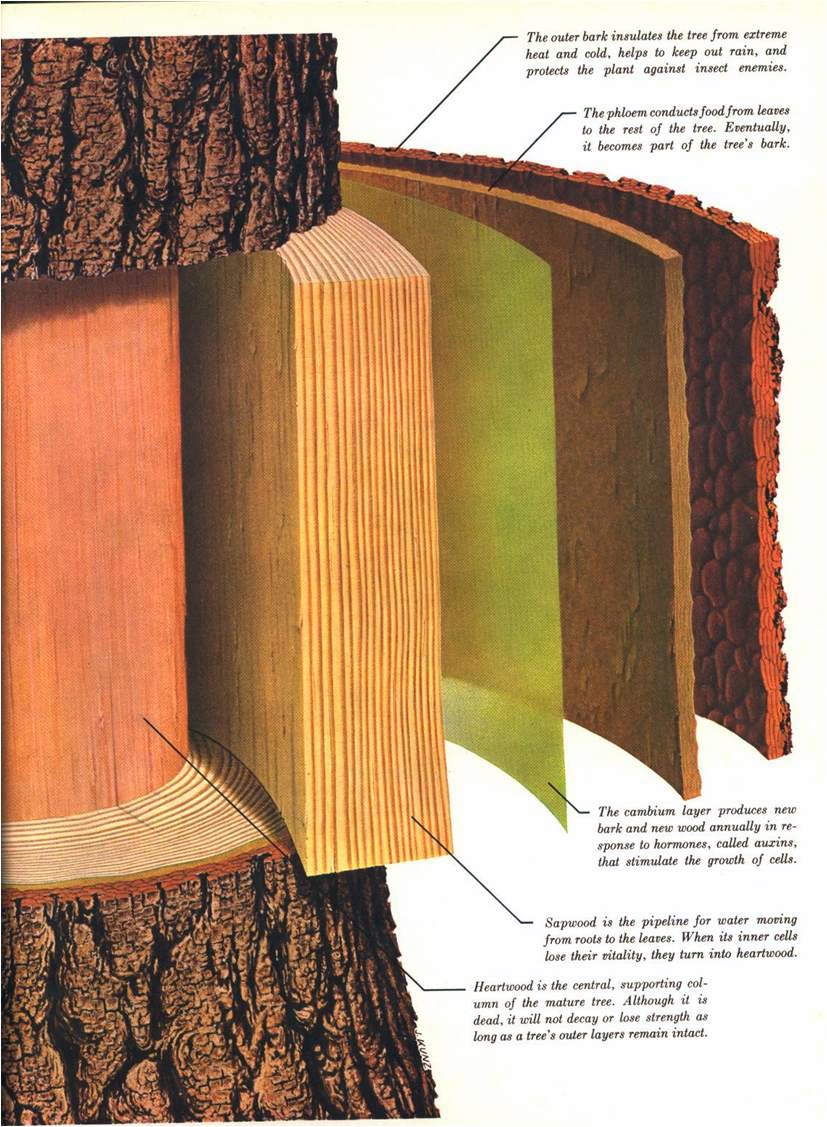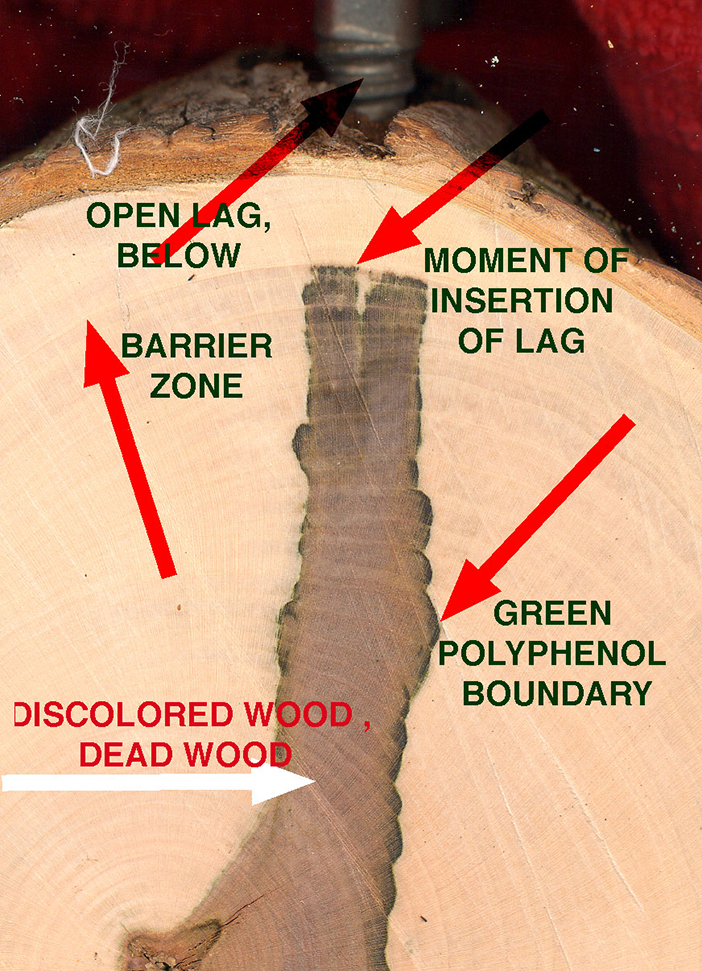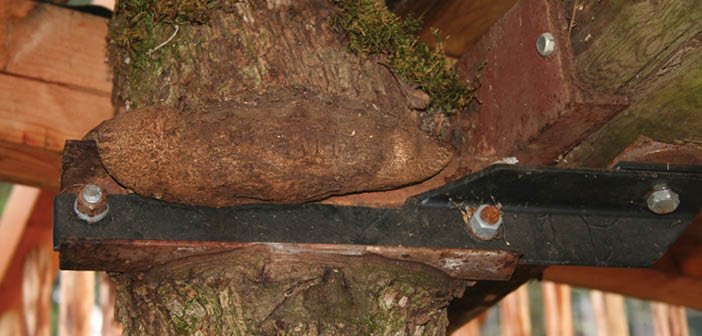Thirty-three years ago, Michael Garnier built his first tree house. He was looking for a way to add some income to his property in southern Oregon. Today, Michael’s property, the Out ‘N About Treesort, has 17 tree-supported structures, most of which are for rent. His influence, though, has expanded far beyond his own property: he launched a fascination with building structures in trees that continues to grow today.
A couple of years after he began his venture, Michael sought me out after a lecture I presented at the Pacific Northwest chapter of the International Society of Arboriculture’s field day. Michael realized that he needed more knowledge about trees, and specifically about potential impacts that would occur over time to the trees and structures he was beginning to build. Over the years, Michael and I have become firm friends, and we have learned a lot about building things in trees.
Bolts in Trees
Arborists have been interested in tree reactions to metal bolts for a long time. We often use cables of various types and steel rods to reinforce trees with structural issues. We do this to reduce the risk to people or property from a failing tree or tree part. Over the decades, we have learned a lot about what works, what doesn’t, and why.
Understanding some basics about tree biology will help anyone who is building structures using trees for support. This knowledge should inform anyone who is either bolting structures to trees or wrapping them.
Impact of bolting. When we make a penetration or a hole in a tree, that should be considered an injury. Luckily, in general, tree species are well adapted to growing around injuries, whether they are made by humans or occur naturally.
When trees are wounded by drilling a hole, or when a branch is shed or the tree’s trunk damaged, they don’t heal like people do. Rather than shedding and replacing damaged cells, trees seal injuries over with new growth: new tree rings, which are layers of xylem/wood.
Understanding CODIT
When the cambium of the tree is wounded, the compartmentalization response is triggered. There are three barriers to the spread of fungal decay that are already present in the xylem. These are described in the CODIT (compartmentalization of decay in trees) model as Walls 1, 2, and 3. The next year’s annual ring forms Wall 4, and the strongest barrier to decay is created.

An example of the CODIT (compartmentalization of decay in trees) response to drilling, showing the barriers to decay, labeled Wall 2, 3, and 4.
Impacts of wrapping. I still encounter people that think you can wrap, or squeeze a structure onto a tree, causing no problems. This is not the case.
Because a tree’s vascular system is located at the outer portion of the plant, just beneath the bark, it doesn’t take much to impede the flow of the products of photosynthesis created in the leaves. Water and assimilates from the soil move up the tree in the outer layers of xylem we call sapwood. The products of photosynthesis flow down the tree in the layers of the cambium. It is possible to interrupt this flow or impede it with both thick- and thin-bark tree species.

Impeding flow through a tree’s vascular layers, diagramed above, can impact future growth.
Long-lived tree species are best. Understanding the differences between various tree species is important in understanding what level of impact building a structure supported by a tree will cause. Generally speaking, long-lived tree species are the best choice for supporting a tree house, zip line, or challenge course element. This is because long-lived trees have developed strong defenses against the fungal, bacterial, and insect organisms they coexist with. This means that long-lived trees have a stronger CODIT response.
Limiting the impacts. Understanding basic tree anatomy and tree growth is also important to limiting the impact from the fittings used to support structures built in trees. Every hole that we put in a tree will impact the vascular system and influence tree growth going forward.
Arborists know that too many branches removed in one area of a tree can result in the tree reacting as if a large wound has occurred across the trunk area that connects the pruning cuts. Builders of tree houses know that when they add heavy loads to the trunk of a tree, a response growth can result and envelop the attachment much more rapidly than was expected based on knowledge of typical tree growth in the location. The moment a hole is drilled in a tree part to accept a metal fitting, physiological changes that are not reversible occur.
The late Dr. Alex Shigo, former chief scientist for the U.S. Forest Service and longtime arboriculture thought leader, was interested in the impacts of the metal bolts and lags arborists use to reinforce trees and reduce risk of failure. His photos of dissections of trees with a bolt or lag insertion are very informative in that they show the decay caused by the insertion as well as the resulting envelopment around the metal fixture.

A dissection shows decay and envelopment caused by a lag screw.
Garnier Case Study
To further examine the tree response over time to metal fittings, Michael Garnier took a series of photos over roughly a decade of the fixtures used to build some of his structures. The fittings photographed are in white or black oak, very durable and long-lived species ideal for containing damage from metal fittings.
The photos show the reaction growth of the trees, and what we see is that the trees create wood above the fittings and eventually envelop the metal, sealing over the fixtures. This happens because the fittings block the flow of the products of photosynthesis from moving down the cambium layers, thus the tree uses those energy-rich products to create wood above the blockage.

A tree envelops a metal fitting over 13 years.
This response is commonly seen when a tree is staked and never untied. You also often see this in older tree-supported structures where an attempt was made to squeeze the component onto the tree, or where a longitudinal component was strongly attached.
Fairly harmless. Over the years, we have seen very little decay resulting from the tree attachment bolts (TABs) holding up Garnier’s structures. If installed properly, these attachments, designed by Garnier and engineer Charles Greenwood, do not seem to cause harm over the long term. Greenwood and others advocate using the natural tree resin substance Lac Balsam to seal the bolt holes prior to setting the TABs, and there is some research that indicates benefits from sealing tree wounds with this substance.
The metal itself is essentially benign. If you were to cut open a tree that had one of his attachments, you may see some staining or discoloration of the wood from a metal fitting. However, the discoloration stems from the tree’s response and activation of the reaction zones, leading to the growth of new layers of tree around the wound (bolt hole) and intrusion as well as reaction growth as the tree responds to the new loads. Thus, the discoloration is not necessarily from decay caused by the fixture.
Potential for harm. This is not to say that inserting new fittings into a tree could not result in the spread of internal decay that is already present in the tree. The existing decay may be contained by the Wall 4 barrier. When a new wound is made, a new Wall 4 will begin to form at the outer edge of the tree. This may allow decay that was previously contained further into the structure of the tree to spread outwards.
Of course, when it comes to decay, if you are using trees that are not as strong at compartmentalization, you should anticipate a shorter lifetime for your course element, and more potential problems for the tree.
A fitting that has been sealed over by new growth also presents several problems, one of the most obvious being that it cannot be inspected. Among other issues resulting from penetrations are the creation of openings for decay fungi to enter the tree, interruption of the tree’s vascular system, and the eventual formation of a “notch” in the tree part that may result in weakness and failure under load.
Looking Ahead
My observation after more than 30 years of working with tree-supported structures is that we still have a lot to learn. We know that trees will accept metal fittings and respond to them in predictable ways, and also that there are certain fixtures and attachments we should avoid in order to extend the life of our structures and our trees, such as anything that girdles or significantly interrupts the vascular system of the tree.
We also understand that it is important to limit the number of penetrations in a tree overall, especially penetrations in close proximity to each other, for the aforementioned reasons.
We do not have good research or understanding of other changes that will result from building something in a tree, such as cyclic loading, changes in the ability of a tree to dampen load, and reaction to forces created by use or by weather-induced loads.
I think that there are people involved with our associations who have the ability to design scientific studies to gather more information about the long-term impacts of the structures we are building in trees. I would be interested in hearing from anybody who has such an interest and helping them find funding to pursue this research.
Reach the author at [email protected].






